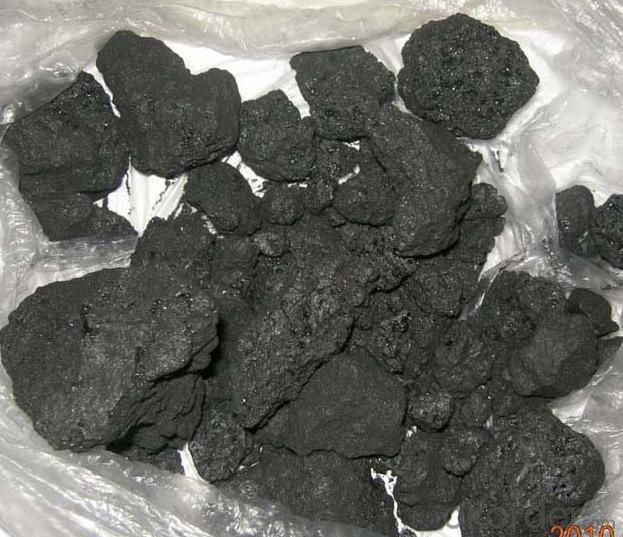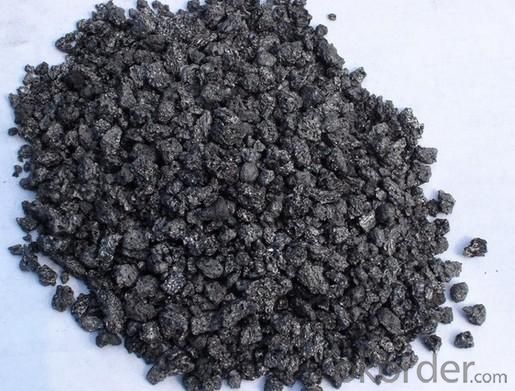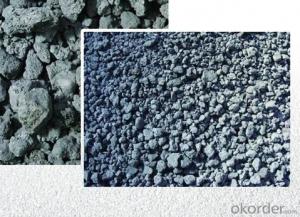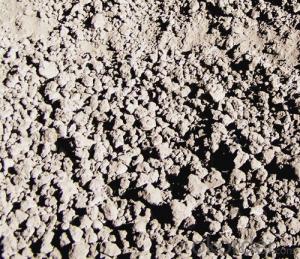High Quality Calcined Petroleum Coke 99%,98.5%,98%
- Loading Port:
- Tianjin
- Payment Terms:
- TT OR LC
- Min Order Qty:
- 1 m.t.
- Supply Capability:
- 10000000 m.t./month
OKorder Service Pledge
OKorder Financial Service
You Might Also Like
1.Structure of Calcined Petroleum Coke Description
Calcined Petroleum Coke is made from raw petroleum coke,which is calcined in furnace at a high temperature(1200-1300℃).CPC/Calcined Petroleum Coke is widely used in steelmaking,castings manufacture and other metallurgical industry as a kind of recarburizer because of its high fixed carbon content,low sulfur content and high absorb rate.Besides,it is also a best kind of raw materials for producing artifical graphite(GPC/Graphitized Petroleum Coke) under the graphitizing temperature(2800℃).
2.Main Features of the Calcined Petroleum Coke
High-purity graphitized petroleum coke is made from high quality petroleum coke under a temperature of 2,500-3,500°C. As a high-purity carbon material, it has characteristics of high fixed carbon content, low sulfur, low ash, low porosity etc.It can be used as carbon raiser (Recarburizer) to produce high quality steel,cast iron and alloy.It can also be used in plastic and rubber as an additive.
3. Calcined Petroleum Coke Images


4. Calcined Petroleum Coke Specification
| Petroleum Coke | |||||||||
| Product Name:Petroleum Coke | |||||||||
| Analysis Project | Specification | Test Method | |||||||
| First Grade product | Qualified Product | ||||||||
| 1A | 1B | 2A | 2B | 3A | 3B | ||||
| Sulfer % | ≤ | 0.5 | 0.5 | 0.8 | 1.0 | 1.5 | 2.0 | 3.0 | GB/T387 |
| volatile % | ≤ | 12 | 12 | 14 | 17 | 18 | 20 | SH/T0026 | |
| Ash % | ≤ | 0.3 | 0.3 | 0.5 | 0.8 | 1.2 | SH/T0029 | ||
| Water % | ≤ | 3 | SH/T0032 | ||||||
| Density g/cm3 | 2.08-2.13 | Report | - | SH/T0033 | |||||
| The amount of powder coke % | ≤ | 25 | - | - | |||||
| Silicon % | ≤ | 0.08 | - | SH/T0058 | |||||
| Vanadium % | ≤ | 0.015 | - | SH/T0058 | |||||
| Fe % | ≤ | 0.08 | - | SH/T0058 | |||||
5.FAQ of Calcined Petroleum Coke
1). Q: Are you a factory or trading company?
A: We are a factory.
2). Q: Where is your factory located? How can I visit there?
A: Our factory is located in ShanXi, HeNan, China. You are warmly welcomed to visit us!
3). Q: How can I get some samples?
A: Please connect me for samples
4). Q: Can the price be cheaper?
A: Of course, you will be offered a good discount for big amount.
- Q:How is carbon used in the production of fertilizers?
- Carbon is an essential component in the production of fertilizers. It is used in various forms such as organic matter, carbon dioxide, and carbonates. These carbon sources are utilized to enhance soil fertility, improve plant growth, and increase crop yield. Organic matter, such as compost, manure, and crop residues, contains carbon in the form of decomposed plant and animal materials. When added to the soil, these organic sources of carbon provide essential nutrients, including nitrogen, phosphorus, and potassium, to plants. They also improve soil structure, water holding capacity, and microbial activity, which are crucial for plant growth. Carbon dioxide (CO2) is another important carbon source used in the production of fertilizers. CO2 is captured from industrial emissions and incorporated into the production process. It is converted into various chemical compounds, such as urea and ammonium bicarbonate, which are widely used as nitrogen fertilizers. These fertilizers release nitrogen slowly, ensuring a steady supply of nutrients to the plants over an extended period of time. Additionally, carbonates, such as calcium carbonate, are used as neutralizing agents in fertilizers. They help to balance the pH levels of acidic soils, making them more favorable for plant growth. Carbonates also provide a source of calcium, an essential nutrient for plants, further enhancing their growth and development. In summary, carbon plays a crucial role in the production of fertilizers by providing essential nutrients, improving soil fertility, and enhancing plant growth. Whether in the form of organic matter, carbon dioxide, or carbonates, carbon is a vital component that contributes to the success of modern agriculture.
- Q:What are the different types of carbon-based concrete additives?
- There are several different types of carbon-based concrete additives that can enhance the performance and properties of concrete. These additives are primarily derived from carbon-based materials and can be categorized into three main types: carbon nanotubes, graphene, and carbon fibers. 1. Carbon Nanotubes: These are cylindrical structures made up of carbon atoms arranged in a unique hexagonal pattern. Carbon nanotubes have exceptional mechanical and electrical properties, making them highly desirable as concrete additives. When added to concrete, they can improve its strength, durability, and toughness. Carbon nanotubes also enhance the electrical conductivity of concrete, which is beneficial for applications such as self-healing concrete and anti-static flooring. 2. Graphene: Graphene is a single layer of carbon atoms arranged in a two-dimensional lattice. It is known for its exceptional strength, high electrical conductivity, and excellent barrier properties. When incorporated into concrete, graphene can significantly improve its mechanical properties, such as compressive strength, flexural strength, and abrasion resistance. It also enhances the durability and impermeability of concrete, providing resistance against water and chemical ingress. 3. Carbon Fibers: These are long, thin strands of carbon, typically derived from organic polymers such as polyacrylonitrile or pitch. Carbon fibers possess excellent tensile strength and are widely used as reinforcements in various construction materials, including concrete. When added to concrete, carbon fibers can enhance its flexural strength, impact resistance, and cracking behavior. They also improve the ductility and toughness of concrete, making it more resistant to dynamic loads. It is worth noting that each type of carbon-based concrete additive has its unique advantages and applications. Carbon nanotubes offer exceptional mechanical and electrical properties, graphene provides enhanced strength and barrier properties, while carbon fibers enhance flexural strength and impact resistance. The choice of additive depends on the specific requirements of the concrete application and the desired performance characteristics.
- Q:What are the main sources of carbon on Earth?
- Both natural and anthropogenic sources contribute to the presence of carbon on Earth. Carbon dioxide (CO2) is naturally released into the atmosphere through processes such as volcanic eruptions, respiration by plants and animals, and the decay of organic matter. Carbon is also found in carbonate rocks in the Earth's lithosphere, formed from marine organisms' shells and skeletons. Anthropogenic sources of carbon primarily arise from the combustion of fossil fuels like coal, oil, and natural gas for energy and transportation purposes. When these fuels are burned, carbon dioxide is emitted, leading to the greenhouse effect and climate change. Deforestation and land-use changes also release carbon stored in trees and vegetation. Furthermore, industrial processes, cement production, and waste management activities contribute to the emission of carbon dioxide and other greenhouse gases. These human activities release carbon that has been sequestered for millions of years, significantly disrupting the natural carbon cycle. In conclusion, although carbon is naturally present on Earth, human actions have greatly amplified its release into the atmosphere, raising concerns about climate change and the urgent need for sustainable practices to reduce carbon emissions.
- Q:How is carbon used in the production of activated carbon filters?
- Activated carbon filters are widely used in various industries and applications, such as water and air purification, gas masks, and even in the production of certain chemicals. In the production of activated carbon filters, carbon plays a crucial role in their effectiveness. Activated carbon, also known as activated charcoal, is a highly porous form of carbon that has a large surface area. This porous structure is achieved through a process called activation, which involves heating carbonaceous materials, such as wood, coal, or coconut shells, at high temperatures in the presence of steam or certain chemicals. The activation process creates tiny pores and increases the surface area of the carbon, allowing it to effectively trap and remove impurities from gases or liquids. These impurities, including organic compounds, volatile organic compounds (VOCs), and certain heavy metals, are attracted to the surface of the activated carbon due to its high adsorption capacity. In the production of activated carbon filters, the activated carbon is typically formed into a granular or powdered form and then packed into a filter medium, such as a cartridge or a mesh. The filter medium acts as a support structure for the activated carbon, allowing the air or water to flow through while capturing and adsorbing the impurities. The activated carbon filters can effectively remove a wide range of contaminants, including chlorine, volatile organic compounds (VOCs), odors, and certain heavy metals. This makes them highly efficient in improving the quality of water and air by reducing pollutants and enhancing odor control. Moreover, the versatility of activated carbon allows for customization depending on the specific application. For example, activated carbon can be impregnated with certain chemicals to enhance its adsorption capacity for specific contaminants, or it can be specially treated to target certain pollutants, such as mercury or arsenic. In summary, carbon is used in the production of activated carbon filters due to its highly porous structure and excellent adsorption properties. These filters are crucial in various industries and applications, effectively removing impurities from water and air, improving their quality, and enhancing overall environmental and human health.
- Q:What is electrical carbon?
- Different uses have different varieties, according to the use of electric carbon varieties can be divided into:(1) sliding contact carbon brushes and carbon sliders for all kinds of motor brushes.(2) various carbon and graphite contacts used in high power switches, relays, etc..(3) with various carbon arc lighting, carbon arc gouging, spectral analysis and arc furnace.(4) all kinds of high purity graphite electrodes, insulation and supporting elements for electric vacuum devices.(5) various electrodes used in dry cells and electrolytic cells.(6) the resistance effect of carbon. Made of various resistance, post, communication with the microphone carbon sand, resistance heating elements etc..
- Q:What is the structure of graphite, another form of carbon?
- Graphite possesses a unique carbon form with a structure that differs from diamond or amorphous carbon. It showcases layers of carbon atoms arranged in a hexagonal lattice. Covalent bonds connect each carbon atom to three neighboring carbon atoms, resulting in a two-dimensional sheet-like structure. Within each layer, the carbon atoms bond together through robust covalent bonds, creating a flat network. The carbon-carbon bonds in graphite are notably stronger than typical single bonds, ensuring the structure's high stability. The hexagonal lattice arrangement of carbon atoms forms a honeycomb-like pattern, giving graphite its characteristic appearance. The layers in graphite remain cohesive due to weak van der Waals forces, enabling easy sliding between them. This attribute grants graphite its lubricating properties and allows it to leave marks on paper when used as a pencil lead. Additionally, the arrangement of carbon atoms in graphite contributes to its exceptional electrical conductivity. The structure's delocalized electrons can move freely along the layers, facilitating the flow of electric current. This feature renders graphite valuable in various applications, including electrical components, electrodes, and as a lubricant in high-temperature environments. In conclusion, graphite's structure comprises layers of carbon atoms organized in a hexagonal lattice. These layers are bonded through strong covalent bonds within each layer and held together by weak van der Waals forces. This distinctive structure grants graphite its unique properties, such as its lubricating nature, electrical conductivity, and versatility in diverse industrial applications.
- Q:How is carbon used in the agricultural industry?
- Carbon is used in the agricultural industry in various ways. One of the main uses is as a fertilizer in the form of organic matter, such as compost or manure, which improves soil fertility and structure. Carbon is also used in carbon sequestration practices, where plants absorb carbon dioxide from the atmosphere and store it in the soil, helping to mitigate climate change. Additionally, carbon-based pesticides and herbicides are used to control pests and weeds in crop production. Overall, carbon plays a significant role in promoting sustainable and efficient agricultural practices.
- Q:What are the advantages of carbon-based solar cells?
- The advantages of carbon-based solar cells include their low cost and abundance of raw materials, as carbon is a widely available element. They also exhibit high efficiency and can be flexible, lightweight, and transparent, allowing for diverse applications. Additionally, carbon-based solar cells have a low environmental impact and can be easily manufactured using scalable techniques.
- Q:What are the impacts of carbon emissions on human respiratory diseases?
- Human respiratory diseases are significantly affected by carbon emissions, especially those resulting from the burning of fossil fuels. The release of carbon dioxide and other greenhouse gases into the atmosphere contributes to climate change, which in turn impacts air quality and worsens respiratory conditions. One of the main outcomes of carbon emissions is the rise in air pollution. When fossil fuels are burned, various pollutants such as nitrogen oxides, sulfur dioxide, and particulate matter are released. These pollutants can irritate and harm the respiratory system, triggering and worsening respiratory diseases like asthma, bronchitis, and chronic obstructive pulmonary disease (COPD). They can also lead to the development of respiratory infections and reduce lung function, making individuals more susceptible to respiratory illnesses. Respiratory health is further affected by climate change, which is fueled by carbon emissions. As temperatures rise and weather patterns change, allergens and air pollutants proliferate, causing more frequent and severe allergic reactions and exacerbating respiratory conditions. Climate change can also extend the pollen season and increase the production of mold spores, leading to asthma attacks and other respiratory symptoms. Additionally, carbon emissions contribute to the creation of ground-level ozone, a harmful pollutant. Climate change enhances the chemical reactions that produce ozone due to higher temperatures and increased sunlight. Ground-level ozone can irritate the airways, resulting in coughing, shortness of breath, and chest pain. It can also worsen existing respiratory diseases and impair lung function, particularly in vulnerable populations such as children, the elderly, and individuals with pre-existing respiratory conditions. In conclusion, the impact of carbon emissions on human respiratory diseases is significant. They contribute to air pollution, which worsens respiratory conditions and increases the risk of respiratory infections. Furthermore, climate change, driven by carbon emissions, intensifies the production of allergens and air pollutants, exacerbating respiratory symptoms and reducing lung function. It is crucial to implement effective measures to reduce carbon emissions not only to address climate change but also to protect respiratory health.
- Q:Whether the CO2 content in the boiler smoke can not be measured, the measurement of carbon content of fly ash ah? @ @ Thank you very much!!!
- Just like oxygen measuring zirconia, the CO2 content has a specialized CO2 sensor that can be measured directly
1. Manufacturer Overview |
|
|---|---|
| Location | |
| Year Established | |
| Annual Output Value | |
| Main Markets | |
| Company Certifications | |
2. Manufacturer Certificates |
|
|---|---|
| a) Certification Name | |
| Range | |
| Reference | |
| Validity Period | |
3. Manufacturer Capability |
|
|---|---|
| a)Trade Capacity | |
| Nearest Port | |
| Export Percentage | |
| No.of Employees in Trade Department | |
| Language Spoken: | |
| b)Factory Information | |
| Factory Size: | |
| No. of Production Lines | |
| Contract Manufacturing | |
| Product Price Range | |
Send your message to us
High Quality Calcined Petroleum Coke 99%,98.5%,98%
- Loading Port:
- Tianjin
- Payment Terms:
- TT OR LC
- Min Order Qty:
- 1 m.t.
- Supply Capability:
- 10000000 m.t./month
OKorder Service Pledge
OKorder Financial Service
Similar products
New products
Hot products
Related keywords





























